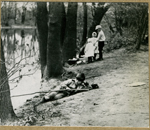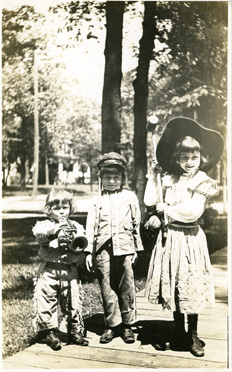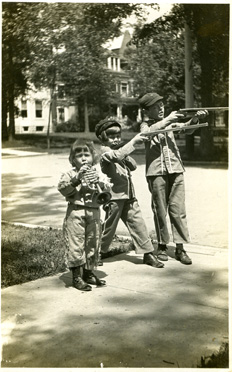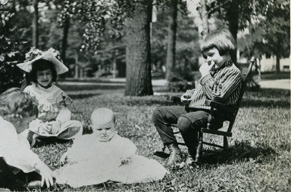Ernest Hemingway
Ernest was born in 1899 in Oak Park, Illinois. He was welcomed as the first son of the Hemingways, and their second child. As an infant, Ernest was often dressed to match his sister Marcelline because Grace Hall Hemingway had wanted twins. In her memoir At the Hemingways, Marcelline remembered that they wore "... a sort of compromise boy-girl costume: ... a belted blouse worn over bloomers", until they both matured and gender could no longer be indistinct for them. This probably encouraged Ernest to develop his own identity. He would become the famous American writer who revolutionized the writing style of the 20th Century, and he would come to embody the classic American male identity. He died in 1961. [4]
{Click an image to enlarge it}
Ernest with his mother Grace Hall Hemingway, in a clearing in Michigan. Grace's dark clothing forces concentration on the baby, while the framing of the photograph suggests that it was a staged portrait of the mother and child. It was important to display the newborn boy and his mother's affection for him. [1899]
Ernest poses with Marcelline, right, and Ursula, left. Ursula plays a trumpet, Marcelline carries a bundle, while Ernest carries a toy gun. His clothing suggests a militaristic attitude. Even during the play of children these ages, gender was resolute.
In this image, Ernest imitates an older boy by pretending to fire the toy gun. Again, he seems militaristic.
From his rocking chair, Ernest appears separated from his siblings and more reserved, sophisticated, mature and masculine.
According to E. Anthony Rotundo, author of American Manhood: Transformations in Masculinity from the Revolution to the Modern Era, young boys were treated much like young girls until about age 6 [5]. Then, boys yearned to escape the domestic world of their mothers and to be stoic, daring, fearless, and jovial, qualities they admired in each other. Ernest must have felt this pressure from youth culture, as well as from the popular culture directed at boys of this time. Catalogues like The American Boy: 1913-1914 were filled with stories about heroism, patriotism, glorified warfare and physical strength. Advertisements focused on weapons, such as "Liquid Pistols", "Marlin guns", and "Stevens guns". This attention to violence and physical achievements encouraged boys to be as masculine as possible, which influenced Ernest as a young boy. [6]





